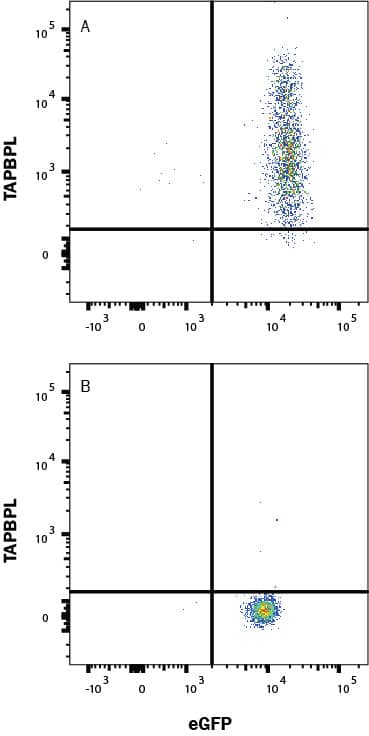Human TAPBPR Antibody Summary
Ala19-Arg404
Accession # Q9BX59.2
Applications
Please Note: Optimal dilutions should be determined by each laboratory for each application. General Protocols are available in the Technical Information section on our website.
Scientific Data
 View Larger
View Larger
Detection of TAPBPR in HEK293 cell transfected with Human TAPBL and eGFP vs irrelevant cells by Flow Cytometry. HEK293 cells transfected with Human TAPBL and eGFP vs irrelevant were stained with eGFP and Mouse Anti-Human TAPBPR Monoclonal Antibody (A, B) (Catalog # MAB11337) followed by Allophycocyanin-conjugated Anti-Mouse IgG Secondary Antibody (Catalog # F0101B). View our protocol for Staining Membrane-associated Proteins.
Reconstitution Calculator
Preparation and Storage
- 12 months from date of receipt, -20 to -70 °C as supplied.
- 1 month, 2 to 8 °C under sterile conditions after reconstitution.
- 6 months, -20 to -70 °C under sterile conditions after reconstitution.
Background: TAPBPR
TAP-binding protein-like (TAPBPL), also known as TAP binding protein-related (TAPBPR) and Tapasin-related protein (TAPASINR) is a transmembrane protein of the Immunoglobulin (Ig) superfamily (1, 2). TAPBPR was originally isolated as a homologue to TAPASIN but more recently was identified as a novel B7 family-related molecule since it shares sequence, structural, and functional similarities to B7 family members (3). Mature human TAPBPR consists of a lumenal domain containing an IgV and IgC domain, a transmembrane domain, and a cytoplasmic tail which lacks an ER retention motif. Within the lumenal domain, mature human TAPBPR shares 70% and 71% amino acid sequence identity with mouse and rat TAPBPR, respectively. Multiple alternatively spliced TAPBPR isoforms are known to exist with unique properties (4).TAPBPR is widely expressed and, similar to TAPASIN, functions as a both a chaperone protein and peptide editor of MHC class I, but in a peptide‑loading complex (PLC) independent manner (5, 6). TAPBPR decreases the rate at which MHC class I molecules mature through the secretory pathway, a role which could be important for peptide selection by MHC class I molecules (7). TAPBPR is also expressed on the surface of T cells and antigen-presenting cells (APCs) and plays an inhibitory role in the proliferation and activation of T cells (4). TAPBPR can be expressed on various cancer cells like leukemia and has the potential to be used in the treatment of autoimmune diseases and transplant rejection, as well as cancer (4).
- Hermann, C. et al. (2015) Tissue antigens 85(3):155.
- Teng, M. et al. (2002) European Journal of Immunology 32:1059.
- Lin, Y. et al. (2021). EMBO Mol Med. 13(5):13404.
- Porter, K.M. et al. (2014) Immunology 142:289.
- Margulies, D. et al. (2020) Current Opinion in Immunology 64:71.
- Boyle, L.H. et al. (2013) PNAS 110:3465.
- Hermann, C. et al. (2013) Journal of Immunology 191(11):5743.
Product Datasheets
FAQs
No product specific FAQs exist for this product, however you may
View all Antibody FAQsReviews for Human TAPBPR Antibody
There are currently no reviews for this product. Be the first to review Human TAPBPR Antibody and earn rewards!
Have you used Human TAPBPR Antibody?
Submit a review and receive an Amazon gift card.
$25/€18/£15/$25CAN/¥75 Yuan/¥2500 Yen for a review with an image
$10/€7/£6/$10 CAD/¥70 Yuan/¥1110 Yen for a review without an image

